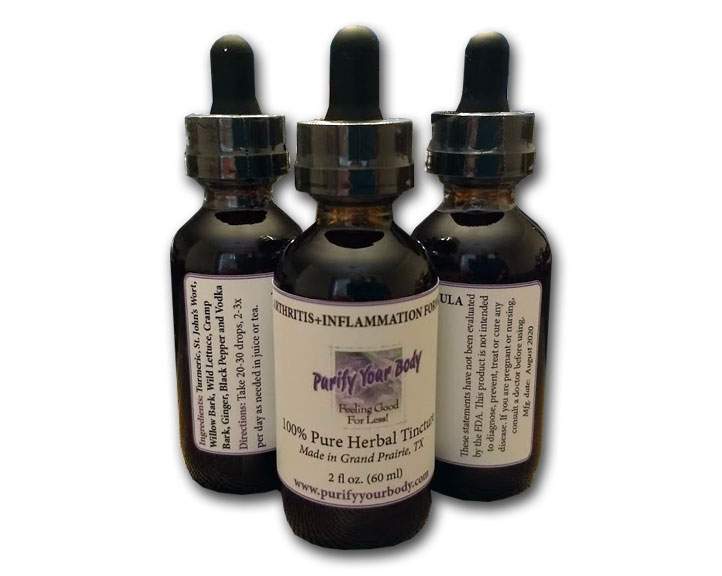Here is more information about my Arthritis + Inflammation formula! This is a really great formula. Let's tell you a little bit more about this formula and how to best use it to your advantage. Many people have chronic pain in their joints, osteoarthritis due to injuries or repetitive motions. Or as my husband says, every day wear and tear, also known as “aging”. This formula was made specifically to help minor chronic pain issues a natural way. From muscles, to nerves and joints, this arthritis + inflammation herbal tincture can help alleviate the pain so you can go about your day. It will be similar to taking a dose of Advil or Alleve. It will not be equivalent to narcotic-type pain relief.Now, the dosage and how to take it.
Dosage: Take 20-30 drops 2-3x per day in juice or tea. You CAN take under your tongue if you want. It is just easier to get down when putting in juice. You can take as needed, or every day.
Why are tinctures a preferred method of taking herbs? Because tinctures are potent! You don’t waste your money on pills that have been in the manufacturing process for months / years and lose potency! With an alcohol base, the tinctures pull out all the medicinal benefits of the plant, and preserve them naturally for you! They don’t lose potency over time. If you forget about this formula in your cupboard and find it in 5 years, you can still take it! It will still be potent! Isn't that cool?
A question I get asked a lot is about the dosage for kids or babies. This formula probably wouldn't be the best to give children, because hopefully they don't have a lot of inflammation or arthritis. But teenagers can take the full adult dose if they need.
Now, the ingredients.
Turmeric: Turmeric and especially its most active compound curcumin have many scientifically-proven health benefits, such as the potential to prevent heart disease, Alzheimer’s and cancer. It’s a potent anti-inflammatory and antioxidant and may also help improve symptoms of depression and arthritis. Benefits are enhanced when together with black pepper.
St, John’s Wort: This herb comes to the rescue for raw nerves and wounds of flesh. It calms anxiety, melancholy and tension of the mind, nerves and body, as well as menopausal irritability. Externally, its antiseptic astringency aids healing of flesh wounds like sores, cuts, bruises, burns, hemorrhoids & varicose veins, and helps to calm swelling, stop bleeding & prevent infection, especially with weak immunity. It is also useful externally for sciatica, arthritis, spine ailments & fybromyalgia – anything ‘nervy’.
Willow Bark: Willow bark is used in a variety of conditions with symptoms of fever and pain. It’s analgesic effects are slower than that of aspiring, but of longer duration and without the gastric side effects. Mild flus and colds with fever, mild headaches and other pain caused by inflammation are indications for this plant. Salix sp. has been used for various forms of arthritis for centuries and is specific for RA and other systemic connective tissue conditions with inflammatory changes. Conditions with inflammation pain such as anyklosing spondylitis, gout, muscular rheumatism, joint pain, OA, osteoporosis, tendinitis, sprains, sciatica and neuralgia it can be of great use. It should be noted that the irreversible inhibition of platelet aggregation seen with aspirin cannot be induced by Willow.
Wild Lettuce: Wild lettuce is believed to have sedative and analgesic (pain-relieving) effects and is often used as a natural remedy for stress and chronic pain. Wild lettuce contains two compounds, known at lactucin and lactucopicrin, that act on the central nervous system. Wild lettuce has the highest concentration of lactucopicrin of all plants, although dandelion root and chicory root are also good sources.
Cramp Bark: Cramp bark is used for relieving cramps, including muscle spasms, menstrual cramps, and cramps during pregnancy. Cramp bark is also used as a kidney stimulant for urinary conditions that involve pain or spasms.
Ginger: A spicy, warming, aromatic spice famous for relieving nausea & indigestion, warming the body, and promoting appetite. In this way ginger is a potential remedy for motion sickness, flatulence, and chemotherapy-induced nausea. As an anti-inflammatory circulatory tonic, ginger may provide relief from rheumatoid arthritis, joint or muscle pain, & bad circulation or cramps – taken internally or applied as a poultice. As a diaphoretic, ginger can bring on a good sweat to help progress a fever, with its antimicrobial powers helping to fight off an invading cold or flu.The relaxing effect of ginger on the abdominal area can also relieve cold menstrual cramps and promote menstruation.
Black Pepper: Black Pepper (Piper nigrum) is used to increase absorption of various water- and fat-soluble nutrients, including vitamin B6, β-carotene, selenomethionine, coenzyme Q10 (CoQ10), curcumin, resveratrol, and others.


No comments:
Post a Comment